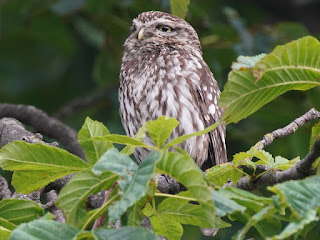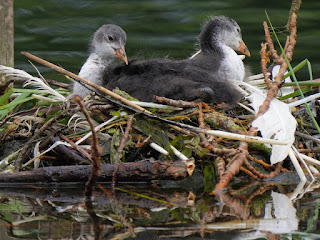A Starling on the Lido restaurant terrace looked around for a chance to raid a table.
A young Starling had found an apple core was busily pecking at it.
A Blackbird near the Round Pond collected insects and a worm for nestlings.
A young Long-Tailed Tit in the Rose Garden had found a larva.
Just an ordinary Great Tit, but it looks fine in the harmonious background of a variegated holly tree.
A Jay bathed in the little pool at the Rima relief. This pool was made specially for birds to bathe and drink in when the relief by Epstein was set up in 1922 in memory of the naturalist W.H. Hudson. Thanks to Nick Abalov for this picture.
Pictures from farther afield: Tom was at Trimingham in Norfolk, where seven Bee-Eaters have nested in a quarry. Here is his picture of two of them.
Mark Williams was in Bridgwater and photographed this young House Sparrow. They are sorely missed in the park.
Beside the Round Pond, a Little owlet looked down from a horse chestnut tree.
Its father was in the next tree.
Ahmet Amerikali got a shot of him flying.
The female Little Owl at the Serpentine Gallery perched calmly on a branch only 10 feet away.
Virginia photographed one of the owlets raising a foot to scratch.
Two of the Coot chicks at Peter Pan rested in their nest.
The moulting Greylag and Canada Geese on the Serpentine are feeling itchy, and are splashing and preening to relieve the irritation.
The shed feathers of hundreds of moulting geese collect in corners of the Serpentine. The debris is full of insects, which these Egyptian goslings were eating.
A male Emperor dragonfly hunted around the reed bed by the Italian Garden.
The long-flowering Rugosa rose in the Rose Garden is still visited by Buff-Tailed Bumblebees which revolve ecstatically in the flowers.



%202022%201a.jpg)
%202022%201a.jpg)
%202022%201a.jpg)


%202022%201a.jpg)

%202022%201a.jpg)



I wonder why they like that flower so much. They go crazy.
ReplyDeleteThe Great Tit is looking splendid, and I think it knows it.
I never would have imagined Bee-Eaters were easy to see in GB!
That sparrow is looking very pale - I imagine the light must give that impression.
Tinúviel
Bee-Eaters are not at all common here. The Collins Bird Guide marks them as V*, meaning a moderately rare vagrant. A lot of people have turned out to watch these visitors.
DeleteThe House Sparrow is strongly lit, but it's also young and I think young birds are lighter in colour.
Loved your itchy geese
ReplyDelete